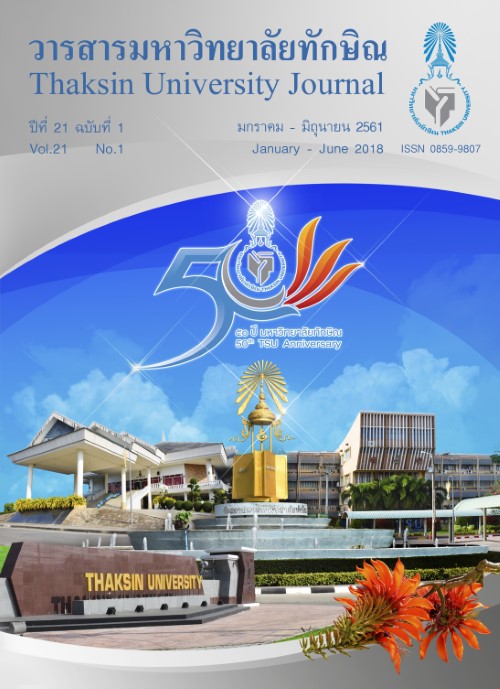Inhibition of Wide Type and Mutant of Influenza a Neuraminidase H1N1 with Oseltamivir, Andrographolide and Derivatives
Main Article Content
Abstract
In this study, molecular docking was performed on the 2009 H1N1 complexed with the well-known
drug, oseltamivir (OTV), andrographolide and derivatives (AGD) from Andrographis paniculata, to investigate
the binding affinity of the inhibitors toward wide type and mutant types at the position of H274Y and R292K
of neuraminidase (NA). The results of OTV revealed that the efficiency of binding is OTV-WT ~ OTV-H274Y
> OTV-R292K in which agree well with IC50 values from experimental data. The calculation revealed that AGD1 and AGD5 are good opportunity for developing as NA inhibitor for WT and H274Y. While AGD2 is a good opportunity for developing as NA inhibitor especially for R292K mutant that has more resistant fold when compare to wide type and H274Y. This is due to the AGD2 binds to NA active site in which the binding energies were -7.95,-8.09 and -7.74 kcal/mol for WT, H274Y and R292K, respectively.
Article Details

This work is licensed under a Creative Commons Attribution-NonCommercial-NoDerivatives 4.0 International License.
References
Thermodynamic and Structural Analysis of Tamiphosphor Binding to Neuraminidase of H1N1 (2009)
Pandemic Influenza”, European Journal of Medicinal Chemistry. 121, 100-109.
[2] Taubenberger, J.K. and Morens, D.M. (2006). “1918 Influenza: The Mother of all Pandemics”, Emerging
Infectious Diseases. 12, 15-22.
[3] Centers for Disease Control and Prevention. (2017). Influenza Type A Viruses. Retrieved 3 August 2016,
from https://www.cdc.gov/flu/avianflu/influenza-a-virus-subtypes.htm.
[4] Chamni, S. (2014). “Influenza Virus and Current Anti-influenza Drugs”, Journal of Science and Technology.
22, 258-271.
[5] Rungrotmongkol, T., Yotmanee, P., Nunthaboot, N. and Hannongbua, S. (2011). “Computational Studies of
Influenza A Virus at Three Important Targets: Hemagglutinin, Neuraminidase and M2 Protein”,
Current Pharmaceutical Design. 17, 1720-1739.
[6] Weinstock, D.M. and Zuccotti, G. (2009). “The Evolution of Influenza Resistance and Treatment”,
The Journal of the American Medical Association. 301, 1066-1069.
[7] Takashita, E., Ejima, M., Ogawa, R., Fujisaki, S., Neumann, G., Furuta, Y., Kawaoka, Y., Tashiro, M. and
Odagiri, T. (2016). “Antiviral Susceptibility of Influenza Viruses Isolated from Patients Pre- and
Post-Administration of Favipiravir”, Antiviral Research. 132, 170-177.
[8] Chen JX, X.H., Ye WC, Fang BH, Liu YH, Yuan SH, Yu P, Wang YQ (2009). “Activity of Andrographolide
and Its Derivatives Against Influenza Virus in Vivo and in Vitro”, Biol Pharm Bull. 32, 1385-1391.
[9] Rungrotmongkol, T., Malaisree, M., Nunthaboot, N., Sompornpisut, P. and Hannongbua, S. (2010).
“Molecular Prediction of Oseltamivir Efficiency Against Probable Influenza A (H1N1-2009) Mutants:
Molecular Modeling Approach”, Amino Acids. 39, 393–398.
[10] Vries, E.v.d., Anber, J., Linden, A.v.d., Wu, Y., Maaskant, J., Stadhouders, R., Beek, R.v., Rimmelzwaan,
G., Osterhaus, A., Boucher, C., et al. (2013). “Molecular Assays for Quantitative and Qualitative
Detection of Influenza Virus and Oseltamivir Resistance Mutations”, The Journal of Molecular
Diagnostics. 15, 348-354.
[11] Kongsune, P., Malee, S. and Doloh, P. (2015). “Inhibition of Influenza A Hemagglutinin H1N1 with
Andrographolide and Derivatives”, Thaksin University Journal. 18, 41-48.
[12] Wang, S.-Q., Cheng, X.-C., Dong, W.-L., Wang, R.-L, and Chou, K.-C. (2010). “Three New Powerful Oseltamivir
Derivatives for Inhibiting the Neuraminidase of Influenza Virus”, Biochemical and Biophysical
Research Communications. 401, 188-191.
[13] Rungrotmongkol, T., Frecer, V., De-Eknamkul, W., Hannongbua, S. and Miertus, S. (2009). “Design of
Oseltamivir Analogs Inhibiting Neuraminidase of Avian Influenza Virus H5N1”, Antiviral Research.
82, 51-58.

